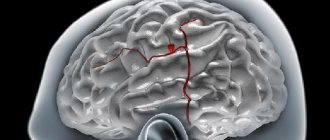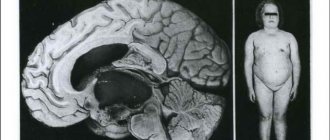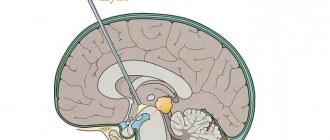How is brain cancer classified?
A brain tumor is a neoplasm that can have different etiologies and vary in class: primary and secondary.
Primary tumors arise in the brain itself and do not metastasize from other organs. Benign neoplasms are localized in one part of the brain, but they do not destroy surrounding tissue, do not metastasize, and do not spread throughout the human body. The benign quality of a tumor is determined by its slow growth rate. And, as a rule, the symptoms depend on the location. So, this can be expressed in attacks of headaches, epileptic seizures, decreased hearing or vision. Quite often, such tumors are asymptomatic and are detected accidentally during examination on a magnetic resonance imaging scanner. In some cases, tumor removal is not possible. For example, in proximity to vital brain structures. Very often, after removal, the disease relapses. Then radiation therapy or re-resection is performed.
Malignant neoplasms. A tumor of this kind can spread to nearby healthy tissues and destroy them. In case of brain cancer, the pathology has a detrimental effect not only on the brain, but also on other organs and cells of the body. Malignant tumors grow very quickly and make themselves felt only in the final stages, when their removal is not possible. Is there a cure for brain cancer? Perhaps with early detection and timely treatment.
How to Simply Recommend
Why the medicine does not work The key to successful treatment is, of course, following all the doctor’s recommendations and informing him of all significant changes during therapy. However, a specialist can talk as much as he wants about the regimen and duration of taking the drug, but most patients will still violate these rules. Read more
A secondary tumor is usually called the spread of cancer cells from other affected organs. Secondary brain cancer is three times more common than primary brain cancer. How long they live with it depends on how actively the metastases attack the brain. As a rule, metastases penetrate the brain in breast, skin, kidney, and lung cancer. Is secondary brain cancer treatable? With this type, the chances are negligible, since metastases have already begun.
Secondary tumors
A secondary tumor is usually called the spread of cancer cells from other affected organs. Secondary brain cancer is three times more common than primary brain cancer. How long they live with it depends on how actively the metastases attack the brain.
As a rule, metastases penetrate the brain in breast, skin, kidney, and lung cancer.
Is secondary brain cancer treatable? With this type, the chances are negligible, since metastases have already begun.
Types of brain tumors
Depending on the location, there is the following classification of neoplasms:
Glioma. The tumor develops from glial cells of the brain. This tumor has 4 stages and is most often found in men and children. Gliomas include oligodendroglioma, epindymoma and mixed glioma.
Meningioma is mostly benign.
Medulloblastoma is a malignant form of neoplasm that mainly affects children.
Lymphoma of the central nervous system is a neoplasm of malignant etiology that affects the lymphatic system.
A tumor of the pituitary gland is an adenoma. A tumor with a benign course.
Tumor of the pineal gland, epiphysis. A malignant neoplasm that makes itself felt only at stage 4, when resection surgery cannot be performed. Is it possible to cure brain cancer with this course? The chances of recovery are low.
Hemangioblastomas are lesions of blood vessels by benign neoplasms.
Neuroma is a lesion of the auditory nerve by a benign tumor. Spinal cord tumors.
Stages of the disease
In order to carry out any treatment, it is necessary to understand at what stage the tumor process is. All over the world it is customary to use the TNM classification. According to this classification, brain cancer is divided into 3 stages:
- T-stage. At this stage, the tumor reaches a certain size and stops growing.
- N-stage. It is decisive in determining the degree of involvement of lymph nodes in the malignant process.
- M stage. Characterized by the onset of metastasis.
Some doctors are more comfortable classifying brain cancer as stage 4. The fourth stage indicates an extensive tumor process with elements of metastasis.
Causes of brain cancer
The exact causes of brain cancer have not yet been established, but there are a number of factors that increase the risk of its occurrence. These include:
- Floor. Men get sick more often than women.
- Age. Most often, a brain tumor can be observed in people over 65. It is typical that children under 8 years of age are also at risk.
- Ethnicity. Compared to others, Caucasians are 2 times more likely to get cancer. For example, glioma is typical for people with white skin.
- Health status. An important cause of brain cancer is diseases of the immune system. For example, HIV infection, organ and tissue transplantation, conditions after chemotherapy.
- Chemical substances. People who work in hazardous industries suffer from brain tumors much more often.
- Heredity. The risk of getting sick increases if one of your relatives has had brain cancer.
- Environment and radiation. People working with radioactive materials are at risk for neoplasms. Researchers recently concluded that the development of brain tumors may be influenced by household appliances and the proximity of high-voltage power lines, as they generate electromagnetic fields that can change the structure of cells. But cell phones and mobile phones are recognized as safe and do not affect the structure of gray matter.
How does brain cancer manifest?
Symptoms of brain cancer vary and depend on the location of the tumor. With primary (focal) signs of the disease, compression and destruction of brain tissue in the area of the tumor occurs. As the tumor progresses, general cerebral symptoms appear, in which hemodynamics are disrupted and intracranial pressure increases.
Focal symptoms
The following lesions are distinguished, which depend on the location of the process:
Motor disorders in the form of paralysis and paresis. There is a decrease in muscle activity and impaired limb function. Impaired sensitivity. In humans it decreases or disappears altogether. It does not react to external stimuli: cold, pain or tactile touch. Very often there is a violation of the ability to determine the position of the limbs relative to the body. Impaired speech and hearing recognition occurs when the auditory nerve is damaged.
Epileptic seizures. Observed with stagnant foci of excitation in the cerebral cortex.
Visual impairment. When the tumor compresses the optic nerve or is located near the quadrigeminal region, partial or complete loss of vision occurs.
Speech impairment. Absence or partial presence of slurred speech. Hormonal imbalance.
Autonomic disorders: fatigue, constant tiredness, dizziness, fluctuations in blood pressure and pulse.
Coordination disorder. When the cerebellum is damaged, the gait changes and the patient cannot make precise movements. Memory is impaired, irritability appears, and character changes.
As the process progresses, complete disorientation in time and loss of one’s own personality occurs.
General cerebral symptoms
Symptoms arise due to increased intracranial pressure and compression of the brain by the tumor.
Headache. They are constant and intense and practically do not stop.
Nausea and vomiting haunt the patient constantly, as there is constant compression of the vomiting center in the midbrain. Dizziness occurs when the tumor presses on the cerebellum.
Symptomatic treatment
The following groups of medications significantly alleviate the patient’s condition, but do not eliminate the main cause of the disease. Glucocortecosteroids help reduce cerebral symptoms. Nonsteroidal anti-inflammatory drugs help relieve pain. Narcotic analgesics are used for severe pain, vomiting and psychomotor agitation.
Surgery
This is the most effective way to treat cancer. The neurosurgeon excises the tumor through healthy tissue. It all depends on the location and stage of the tumor. In practice, the operation is effective only at stage 1. At subsequent stages of the disease, treatment tactics are different. In particular, radiation therapy is used.
Radiation therapy
Such therapy is necessary to stop the growth of pathological cells. It is also carried out before and after surgery.
Chemotherapy
Typically, this treatment is prescribed when the tumor is at the last stage and is inoperable. The dose and type of specific drugs for each patient are calculated individually.
Chemotherapy
Chemotherapy is an important aspect in its treatment. The principle of this treatment is to prescribe special cytotoxic drugs that affect rapidly multiplying pathological cells. The peculiarity of abnormal cells is manifested in their increased metabolism and, accordingly, their reproduction in the form of genetic mutations, which makes them susceptible to chemotherapy.
As a rule, chemotherapy is carried out in courses with short breaks. This allows your body to have the rest it needs to recover. It is also worth noting that chemotherapy in most cases is carried out after surgical removal of the tumor.
I use the following methods of chemotherapy for treating tumors:
- Convection method. It involves implanting a thin plastic catheter into the tumor tissue itself, through which the chemical is directly injected.
- Systemic method of administering chemotherapy. Typically, this method is used through intravenous administration of the necessary drugs.
- Intrathecal. It consists of administering the drug by lumbar puncture into the cerebrospinal spinal fluid. As a result, the chemotherapy drug specifically affects brain tissue. The drug can also be injected directly into the tissue itself.
Among the drugs used in chemotherapy are:
- Temozolomide;
- Carmustine;
- Platinol;
- Paraplatin.
As we have already noted, chemotherapy affects abnormal cells, but such cells can also include completely healthy ones, which tend to increase metabolism and growth. Therefore, chemotherapy can cause a number of complications in other organs and systems of the body.
Common complications after chemotherapy include:
- Infectious diseases;
- Increased bleeding;
- Nausea, vomiting and diarrhea;
- Impaired kidney and liver function.











